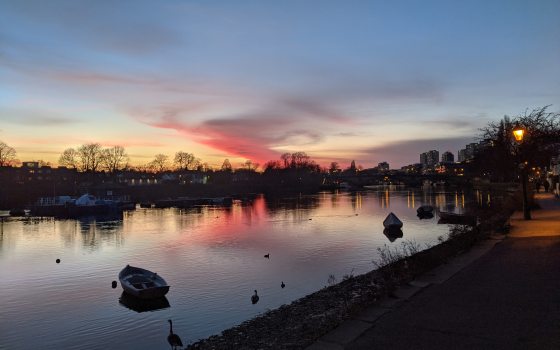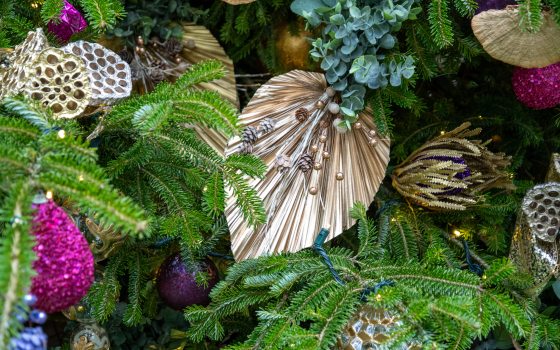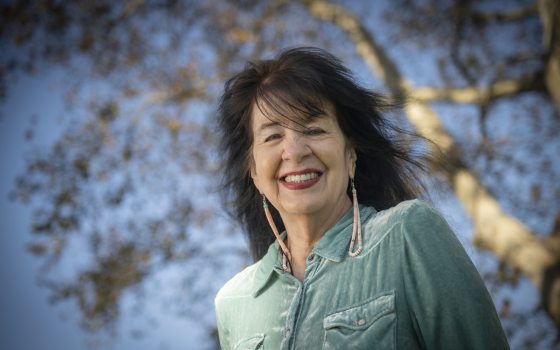As part of the Fellows Program, Fellows spend two months with partner organizations around the world to learn from thought leaders, immerse themselves in their host’s culture, and share and grow their own expertise. Here, our Fellows reflect on lessons learned and memories made during their field placements in London, Singapore, Niagara Falls, Cleveland, and Edinburgh.
Amanda Hannah
Royal Botanic Gardens, Kew (London, England)
During my recent field placement experience at Kew Gardens in London, I had the pleasure of working on projects with two incredible teams: the Youth Programs team and the Formal Learning team. In my role, I was tasked with helping to develop a five-year framework for the youth programs and evaluating apprenticeship models for Kew's on-site youth teachers. Through my work with these teams, I learned valuable lessons on connecting young people to science and conservation, investing in professional development, and advancing equity and access.
Working with the Youth Programs team was both a joy and an inspiration. After an initial deep dive into their programs, I created a series of facilitated workshops that we used as a basis to develop a comprehensive framework for their programs over the next five years. The framework prioritized growing existing programs and creating meaningful and educational experiences for youth to learn about science, plants, and conservation. A big priority of visioning these programs is for young people to be involved in leading conversations on science policy and decision making at Kew and in national and international forums. Building on Kew’s outreach strategy, another key aspect of youth programs is to ensure inclusivity and accessibility for all, but especially those groups who have been left out. The team was incredibly passionate and dedicated to creating a program that fosters a love for nature and inspires young people to become environmental stewards.
Working with the Youth Programs team showed me the incredible potential of young people. They have wisdom, insights, and perspectives that we often overlook. Cultivating relationships with the youth who will become our future environmental leaders is invaluable, and it is crucial that we provide them with empowering spaces to act and lead.
In collaboration with the Formal Learning team, I evaluated apprenticeship models for Kew's youth teachers. With over 90,000 school-aged children visiting Kew each year there is always a need for diverse, engaged, and well-trained teachers. The Formal Learning team wanted to explore apprenticeships as an option to help fill that need. I evaluated several models and with the team found a new type of apprenticeship model that would allow more flexibility to accommodate their program needs. I then wrote a strategy with next steps for implementing the model. As an added benefit, the strategy provided an avenue to recruit and train teachers in a new way and from backgrounds that may not traditionally apply to teach at Kew.
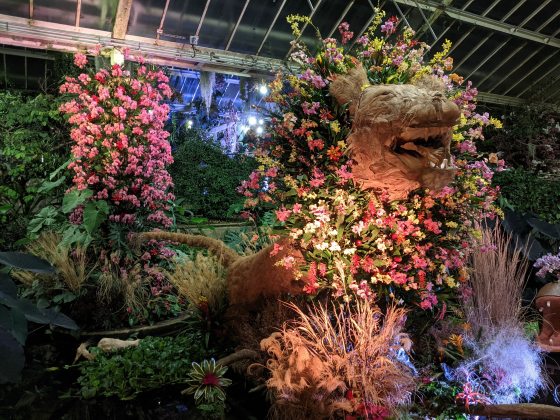
One of the many horticultural wonders I experienced at Kew was an orchid display celebrating Cameroon. Photo by Amanda Hannah.
The biggest takeaway from my work with the Formal Learning team was recognizing the pressures faced by nonprofits, especially those that work with school children, in recruiting, training, and keeping teachers. The school year is marked by large fluctuations in demand, and it takes careful planning, reflection, and collaboration to develop impactful learning environments given these constraints. By continuing to look for ways to improve and diversify their training and recruiting options, Kew shows that its dedication to professional development for educators is unwavering.
One of the things I admire most about Kew is their commitment to ambitious equity and outreach strategies on a public stage. With one-pound access tickets, outreach programs for underserved communities, and partnerships with schools and community groups, Kew is increasingly promoting equity and access. These strategies serve as a reminder that botanical gardens should not only be centers of environmental education and research efforts, but also places where individuals of all ages, backgrounds, and abilities can enjoy nature's beauty and benefits.
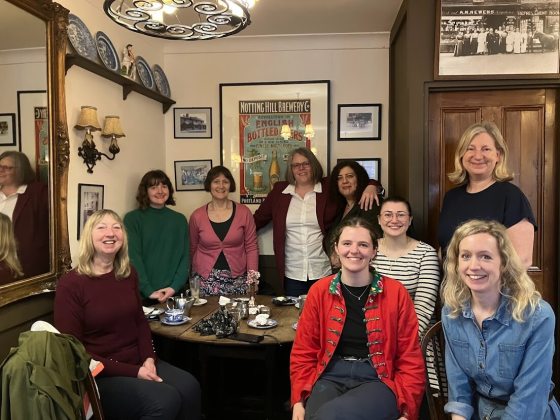
In addition to the two teams that I was fortunate to directly work with on my projects, I would be remiss not to also thank the Grow Wild team who generously welcomed me into their space and helped support me any way they could … including a great deal of tea, a caterpillar cake on my birthday, and numerous treasured afternoon garden walks. Above is my farewell tea at The Original Maids of Honor with the Grow Wild team. Photo provided by Amanda Hannah.
My experience at Kew was transformative. It taught me to prioritize cultivating relationships with young people to build the next generation of environmental leaders. It showed me that teaching is a craft that demands intentional planning, reflection, and collaboration. Finally, it inspired me with its commitment towards advancing equity and access, working to providing an inclusive space for all. It is clear that Kew’s programming and outreach strategies will have a profound impact on Kew, and the communities they serve, for years to come.
Danny Cox
National Parks Board of Singapore
As a US-based Fellow, I sought field placement internationally with the National Parks Board of Singapore (NParks). With my background at Naples Botanical Garden, which features an Asian garden that highlights the architecture and plant communities of Southeast Asia, I have always dreamed of getting a first-hand perspective of gardening in this area of the world.
For Singapore, gardens and green spaces are more relevant now than they have ever been. With a smaller land area and comparable population density to that of New York City, gardens and parks serve as the last remaining spaces for cultural heritage and plant and wildlife habitat on the small island country. As I was going into the field placement, I was hoping to learn more about the strategies behind nursery management and community garden initiatives with NParks. But by the conclusion of the field placement, I learned so much more! This was my first time living in a country outside the U.S. It was an eye-opening experience to be the odd person out, and reinforces my respect for immigrants and international visitors to the U.S. I am so grateful to the many NParks team members who helped me feel welcomed and helped give me a sense of belonging.
The National Parks Board is “dedicated to transforming Singapore into a City in Nature.” My placement time was evenly split between two National Parks Board teams who support this charge: the Pasir Panjang Nursery team and the Community in Bloom team. Through these teams, I got to explore the horticulture wonders of Singapore, including Gardens by the Bay and Singapore Botanic Gardens.

Panoramic view of a small section of Pasir Panjang Nursery. Photo by Danny Cox.
Pasir Panjang Nursery is NParks’ primary nursery production and holding site for growing and staging trees for city greening projects, including the ambitious OneMillionTrees Movement. This initiative aims to restore nature back into the city through the planting of a million more trees across Singapore over the next 10 years. With the Pasir Panjang Nursery Team, I got to help sow seeds, start cuttings, and transplant seedlings into larger pots, learning from the various nursery managers their approach to tried-and-true horticulture techniques. The plants I worked with were wild-collected native plants, a priority group of plants for the project, that are adapted to the natural growing conditions of Singapore. In addition to propagating their own plants, nursery team leaders regularly go to Malaysia, Thailand, and other horticulture hubs in Asia to ensure there will be enough trees to meet the project goals. The efforts of this project will serve as a learning model for large urban forestry initiatives in the years to come.
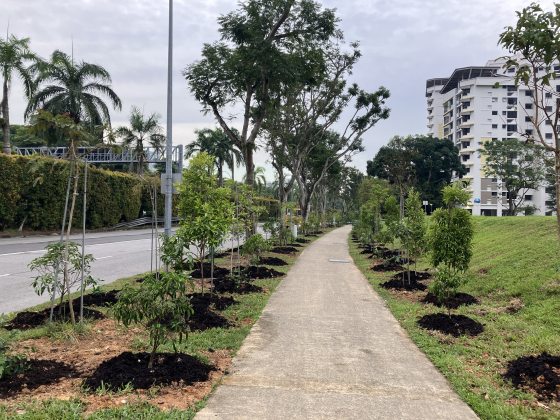
Recently planted trees along a Singapore sidewalk as part of the OneMillionTrees movement. Photo by Danny Cox.
The Community in Bloom team officiates and supports over 1,800 community gardens throughout Singapore, and it is estimated that this number will grow to 2,000 community gardens by the end of 2023. These include community-driven vegetable and ornamental gardens, allotment gardens, and therapeutic gardens. These gardens are a celebrated space for community gatherings and a space where people can access nature on the densely built island.
With the Community in Bloom team, I helped facilitate a workshop for a community allotment garden sited on the roof deck of a parking garage. The space featured 400 small allotment gardens. In the workshop, I helped the community gardeners troubleshoot challenges they were facing in their plots. My favorite moment was showing someone how to harvest their first carrots; it was a huge cause for celebration because no one in the community had experienced growing carrots – let alone growing them to harvest! I hope to take the lessons of how the Community in Bloom team supported these small community gardens and apply them to the future gardens I will lead.
My placement was not only about what I could learn from my host organization but also about what I could contribute to the teams that were so generous with their time and resources. As an experienced horticulturist with a specialization in water garden management and aquatic plants, I was able to share my expertise with NParks staff in several ways. I presented on a staff training webinar series about my experiences growing competition waterlilies for the International Waterlily and Water Gardening Societies’ New Waterlily Competition. I also contributed to a field guide booklet for the common aquatic plants of Singapore, introductory how-to content for the Community in Bloom resource website, and a hands-on in-person workshop on cultivating waterlilies.
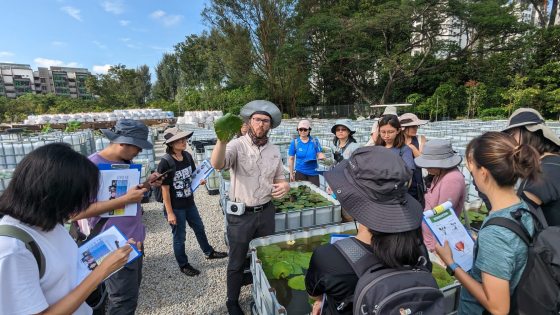
Fellow Danny Cox leads a session with National Parks Board staff on cultivating waterlilies. Photo provided by Danny Cox.
One final observation gave me hope and inspired me about the future. I noticed that among the staff of the nursery team, Community in Bloom team, and team members from the National Botanical Garden or Jurong Lake Gardens, there were many people around my age. It was one of the first times I saw so many relatively young professionals in key leadership roles for horticulture. Maybe my age is finally catching up to me, but I usually find myself as one of the youngest members of most groups I interact with. For example, I may have been one of the youngest general members and board members of the International Waterlily and Water Garden Society. I have often been curious whether I will be lonely when I get to be the age of my older colleagues, but because of this experience, I’m starting to think that I will continue to find my demographic actively engaged with both leadership and horticulture.
Ana Mena
Royal Botanic Gardens, Kew (London, England)
On February 6, 2023, I arrived at Heathrow Airport, excited to begin my field placement at the Royal Botanic Gardens, Kew. Kew is a historic botanical garden in London, England, as well as a UNESCO World Heritage Site that began as a royal botanic garden over 250 years ago. To this day, Kew works beyond its garden walls and is a global leader for scientific research and conservation of the world’s plants and fungi. While at Kew, I expected to learn new skills in interpretation and explore the historic glasshouses and arboretum of a beautiful garden. However, my experience surpassed my expectations as I made lifelong friends and colleagues, shared ideas, and saw how a bold leadership vision can align stakeholders across an organization.
For the Longwood Fellows, field placement is an opportunity for applied learning where we can leverage and test the leadership skills we developed during the first eight months of our program. For me, it was also an opportunity to collaborate with an international partner and leader in public horticulture to expand my expertise and thinking around visitor experience and master planning.
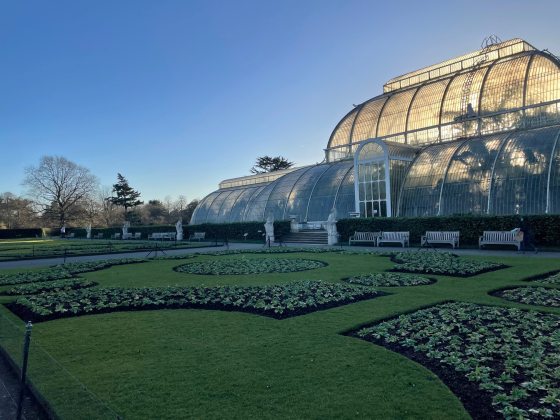
The Kew Palm House. Photo by Ana Mena.
On my first day at Kew, I was invited to an all-staff meeting, where I learned about Kew’s Manifesto for Change: a strategic plan that boldly outlines how Kew’s expertise will address the global biodiversity crisis. Beyond a strategic 10-year plan, it’s an urgent call to action and a long-term vision for transforming our relationship with nature and focusing efforts on restoration, rewilding, and engaging with communities to address environmental justice. While an organization’s strategic plan is often forgotten in day-to-day implementation, at Kew I quickly saw how this Manifesto for Change was an active strategy able to be implemented by all in the organization. It provided a greater purpose and clear direction for day-to-day efforts, as I soon learned while working on a project with Kew’s Interpretation team.
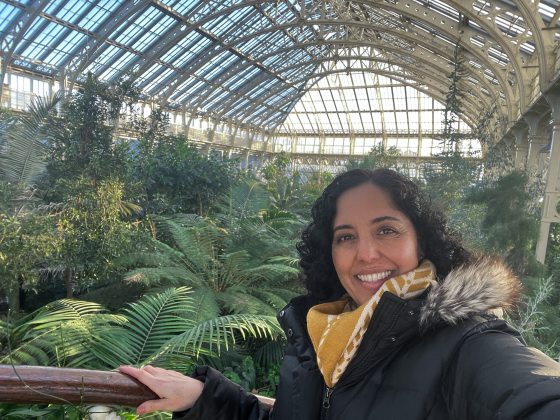
Fellow Ana Mena in the Kew Temperate House. Photo by Ana Mena.
The Interpretation Studio at Kew, led by Head of Interpretation Dr. Sharon Willoughby, hosted my stay in London. A team of three interpretation producers and Dr. Willoughby are responsible for visitor interpretation, from directional signage to informational panels teaching visitors about the importance of global biodiversity, Kew’s rich history, and important plant and fungi scientific research.
My project focused on interpretation master planning, which is the process of deciding and documenting what storytelling themes will be told, where, when, and how. By leveraging my physical master planning spatial skills, I worked with Dr. Willoughby and the team to visualize storytelling across the Kew landscape. I led a brainstorming workshop, where we identified areas for visitor interaction with different storytelling topics, discussed opportunities for self-led interpretation trails, and identified stories yet to be told. We asked many questions and had engaging conversations on the types of stories being told and the relationship of storytelling to the garden master plan.
With our discussion in mind, I mapped out and analyzed the visitor’s storytelling experience across the garden. I analyzed how often different storytelling themes were used to amplify Kew’s mission “to understand and protect plants and fungi, for the wellbeing of people and the future of all life on earth.” This project taught me a new way to understand storytelling topics and themes and the importance of evaluating the alignment of themes with mission.
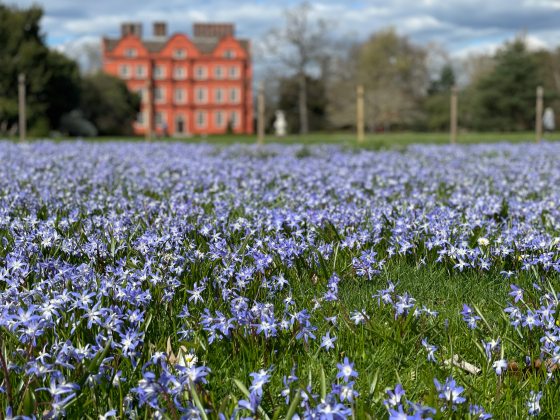
Glory of the Snow (Scilla forbesii) blooms in front of Kew Palace. Photo by Ana Mena.
Throughout my field placement, I had enriching conversations with my Kew colleagues, including interpretation professionals, marketing professionals, landscape architects, horticulturists, Geographic Information Systems (GIS) specialists, and Kew leadership. I returned with a new lens with which to view interpretation, and a sincere appreciation for Kew’s bold vision communicated through Kew’s Manifesto for Change: “a strategy to reverse the environmental devastation of biodiversity loss and climate change.”
Ryan Gott, Ph.D.
Niagara Parks Commission (Niagara Falls, Ontario, Canada)
My field placement in Niagara Falls, Ontario, was not my first visit to the falls. Last August, the Fellows took a group trip to Niagara Parks to learn about some of the amazing work they do in natural conservation and historic preservation as it relates to their mission of being stewards of the iconic Niagara River corridor and keeping the falls freely accessible to all. This initial visit certainly did the trick, as I was then convinced Niagara Parks was where I wanted to go during field placement. The breadth of their work and the depth of their expertise—and, admittedly, a familiar native plant palette that I love from back home in Pittsburgh—were too great to pass up.

The Horseshoe Falls, with their nearly permanent rainbow, aren’t a bad sight to have on your daily commute. Photo by Ryan Gott.
In my time with the Niagara Parks, I was focused on a 10-acre piece of their over 3,200-acre, 36-mile-long parklands. Located just minutes south of the famous Horseshoe Falls, the Dufferin Islands are the subject of a new project charter at the Parks, and I was to work on the educational activation of the space. Diving into an interpretive plan for the site, I soon realized how connected this piece would, and should, be to everything else happening on the islands. Interpretation would be a key component in successfully restoring eroding shorelines, moving visitors through hiking trails, and ensuring the overall ecological wellness of the site.
I began learning the site’s history, including the impact of ancient glaciers, the late-1700s industries that sprang up in its waters, the 1800s tourism through its woods, the two early-1900s completely human-driven redesigns of much of the space following the entry of a hydroelectric generating company, and the connections that the Indigenous Peoples of the Niagara region have between the islands and their living cultures and stories. I read dozens of Parks documents including master plans, viewshed reports, archaeological assessments, and communication strategies. I met with Parks staff on teams spanning events, conservation, education, sales, and heritage to hear about their needs and knowledge of the site. I visited the Dufferin Islands every week, observing how visitors use the space, the natural life that grows there, and mapping out many aspects of the islands’ physiography. And I returned to the interpretive plan over and over again to envision how it all worked together.
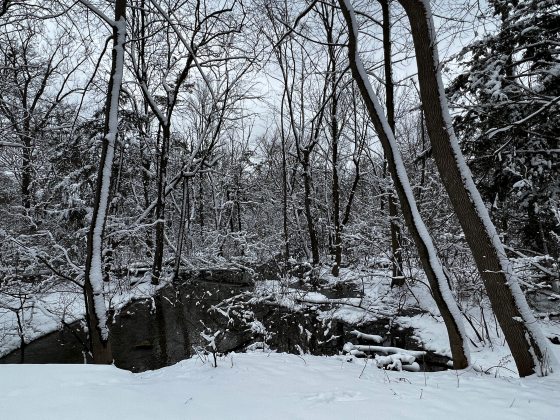
The Dufferin Islands provide year-round beauty and wonder just minutes from the Niagara Falls. Photo by Ryan Gott.
I set out to develop an interpretive theme for the islands that grew from all the stories I discovered: it was a place embodying the truth of the reciprocal relationship between human and nature. This foundational theme organically guided the placement of recommended trails, the creation of interpretive signage connecting visitor to place and evoking action, and the suggestion of site-specific educational programs to leverage the islands’ many unique features and phenomena. I’m so grateful to have had the chance to think systemically and deeply about a singular place, connect with so many individuals across departments, and conceptualize and operationalize knowledge and needs into recommendations grounded in mission, education, and conservation. My time with Niagara Parks was short, but I hope it was as valuable to them as it was to me. And while my field placement may not have been my first visit, I also know it definitely won’t be my last.
Rae Vassar
Royal Botanic Garden Edinburgh (Edinburgh, Scotland)
My time at the Royal Botanic Garden Edinburgh (RBGE) has undoubtably been among the top highlights of my time as a Longwood Fellow. During my two months at RBGE, I was able to dig into a project that I am passionate about while also gaining exposure to strategy and operations at all levels of this inspiring organization.
More than 350 years old, RBGE not only celebrates its illustrious past but has a clear eye on the future. Responding to the biodiversity crisis and climate emergency is at the center of its work, both as a world-class science institution and as a visitor destination that hosts a million visitors a year across four gardens: Edinburgh, Benmore, Dawyck and Logan. The distinct climates of the four sites offer ideal conditions for the organization’s conservation work, which spans more than 35 host countries. I had the privilege to meet with the curators of each garden and travel to see the gardens—which vary greatly in size, scope, and character—in person.
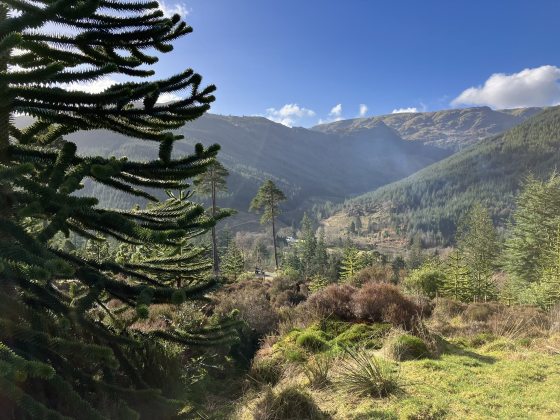
Benmore Botanic Garden. Photo by Rae Vassar.
Each garden has its unique opportunities and challenges in terms of visitorship and business models, but all are dedicated to the unified mission of exploring, conserving, and explaining the world of plants for a better future. Staff from each garden travel to threatened ecosystems to implement recovery and restoration programs, as well as undertaking ex-situ plant conservation —conserving and maintaining plant samples at their own sites, away from the plant’s natural habitat, as a way of protecting endangered species.
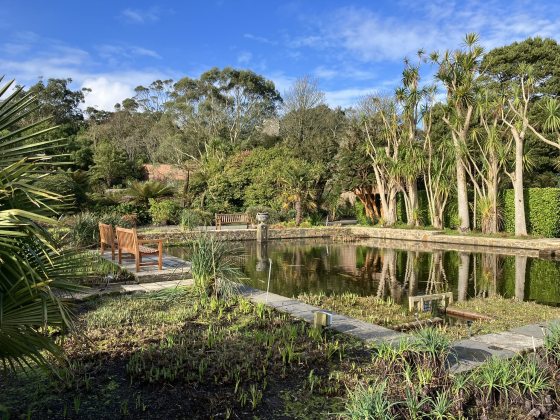
Logan Botanic Garden. Photo by Rae Vassar.
My work fell squarely into RBGE’s response to the climate emergency; specifically, I focused on adaptations to a changing climate. Drawing on RBGE’s existing efforts to prepare for current and future flooding (due to more frequent extreme rain events), along with my own experience in environmental advocacy and landscape architecture, I looked beyond the garden walls to provide strategic and tactical recommendations regarding the expansion of blue-green infrastructure in Edinburgh and throughout Scotland. This work allowed me to meet with staff from across the horticulture, science, community engagement, education, and facilities teams at RBGE, as well as allied nonprofit leaders, design professionals, and government officials. My last week at the garden, I was able to share my policy, finance, and operational recommendations with the RBGE Board of Governors, who seemed genuinely excited about the opportunities for RBGE in this sphere.
Meeting with the Board of Governors is a favorite, but it is certainly not the only example of the type of access that RBGE afforded me during my field placement. My host, Director of Horticulture Raoul Curtis-Machin, made sure I was included in every curator’s meeting, senior leadership team meeting, and executive team meeting during my stay. He also introduced me to horticultural leaders from throughout the U.K., both for my research and my general leadership development. The generosity and hospitality that he and the rest of the RBGE team showed me provided a model of warm, gracious, and humble leadership that I will take with me long into the future.
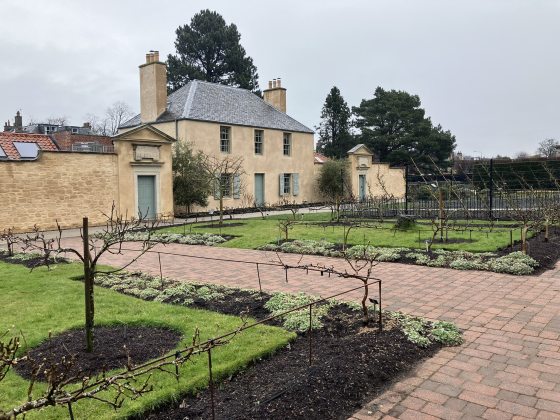
Royal Botanic Garden Edinburgh. Photo by Rae Vassar.
My two-month field placement at RBGE may have come to an end, as will my 13-month fellowship at Longwood Gardens in the not-so-distant future, but the experience of both will stay with me for the rest of my life.
Rama Lopez-Rivera
Holden Forests and Gardens (Cleveland, Ohio)
I spent two months on field placement with Holden Forest and Gardens (HF&G) in Northeast Ohio. During this time, I was based in Holden’s Horticulture & Collections Department, where I reported to HF&G’s Vice President of Horticulture Caroline Tait … who herself was a Longwood Fellow!

Longwood Fellow Rama Lopez-Rivera with Holden Forest and Gardens Vice President of Horticulture Caroline Tait. Photo provided by Rama Lopez-Rivera.
I divided my time at HF&G between The Holden Arboretum in rural Kirtland, Ohio, and the Cleveland Botanical Garden in urban University Circle. It was incredible learning how both campuses function and how different they are in their living collections, size, and location. Together, they interconnect perfectly into a formidable botanical organization that holds collections representing swathes of global flora from a diverse range of biomes, stretching from the northern temperate forests of East Asia, Europe, and North America in the Holden Arboretum’s outdoor living collection. The Cleveland Botanical Garden houses collections under glass tropical rainforests of Central America as well as a Madagascar collection (Madagascan Spiney Desert).
Equally important to these collections are the highly skilled horticulturists who manage them, and it was an exceptional learning experience to be able to join a number of walks with the horticulturists in charge of their individual areas, along with the Vice President of Horticulture and the two directors of horticulture, who continually work to improve the space for both the guest experience and the potential of the collection/landscape design. I was able to learn a huge amount from these sessions, particularly as Caroline Tait was able to translate leadership lessons for me through her experience of having been on the Longwood Fellows Program in our weekly check-ins. The opportunity to have gained practical insight at HF&G, backed up by my coursework at Longwood, will have a tremendous impact on my development as a leader. I also saw firsthand what can be achieved by working as a team to evaluate a landscape through a past, present, and future lens to achieve maximum success.
At HF&G, I was delighted to spend time with their two curators: Curator of Living Collections Tom Arbour and his team based at the Arboretum, and Curator of the Rhododendron Collection, Connor Ryan, based at HF&G’s third site, The Leach Research Station. Working with the curators were some of the most memorable experiences of my time at HF&G. Through them both sharing their expertise, I learned how such a diverse botanical collection is tracked through precise plant records, mapping, and labelling across all of HF&G’s sites, as well as how they identify future collection priorities.
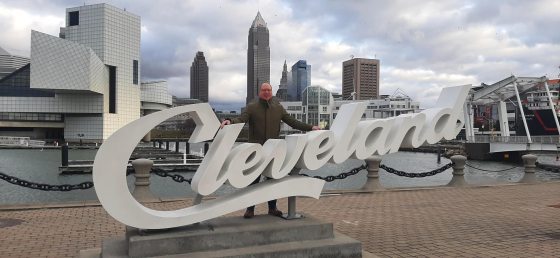
Fellow Rama Lopez-Rivera. Photo provided by Caroline Tait.
Throughout my field placement, I worked on developing a project that aided horticulturists in designing garden areas that integrated the Curation department with other stakeholders across HF&G into their landscape designs. This was achieved through a step-by-step process in the form of a checklist and flowchart, to assist horticultural staff in confirming their designs were meeting the needs of the organization during a series of defined steps throughout the process.
In addition to working within the Horticulture & Collections department, I was extremely grateful to be to have gained an insight into the work of HF&G’s Board, and as well as being able to meet with members of the leadership team, who helped make my field placement a truly exceptional learning experience. I am deeply grateful to everyone at HF&G for helping me in my leadership journey with the Longwood Fellows Program.
Editor’s note: If you’re looking to pursue a senior leadership role in public horticulture, or know someone who is, apply or nominate a candidate to be part of our 2024-25 Fellows Cohort. Nominations are open throughout the year for the upcoming cohort. Applications for our 2024-25 Fellows Cohort close August 31, 2023.
